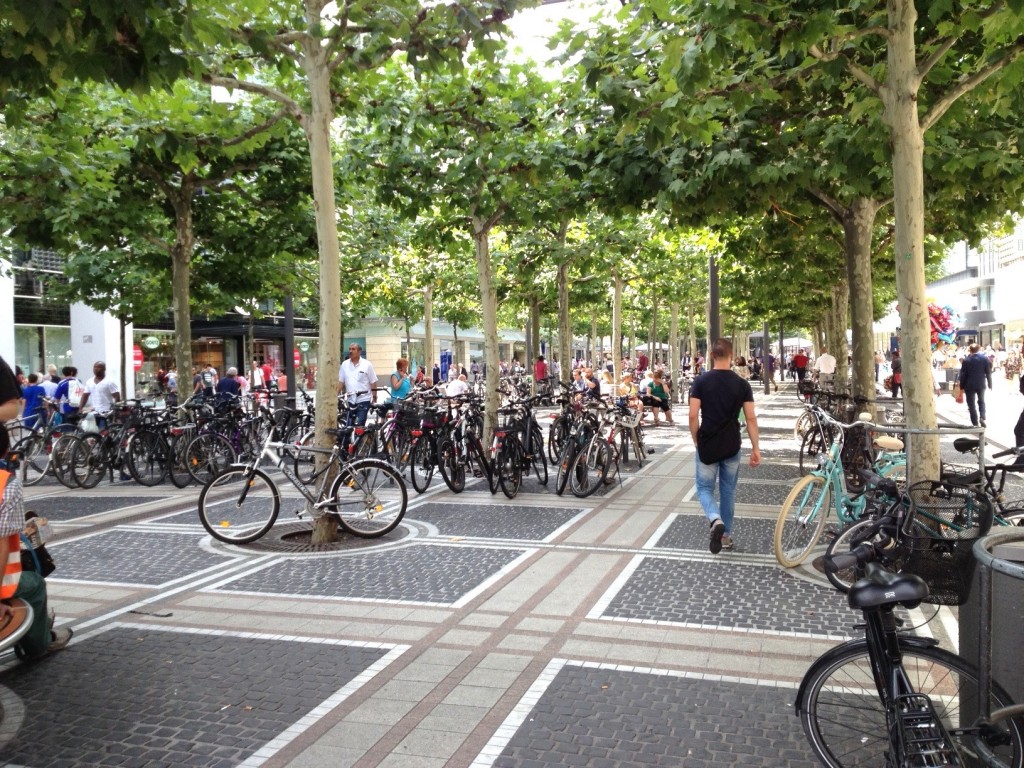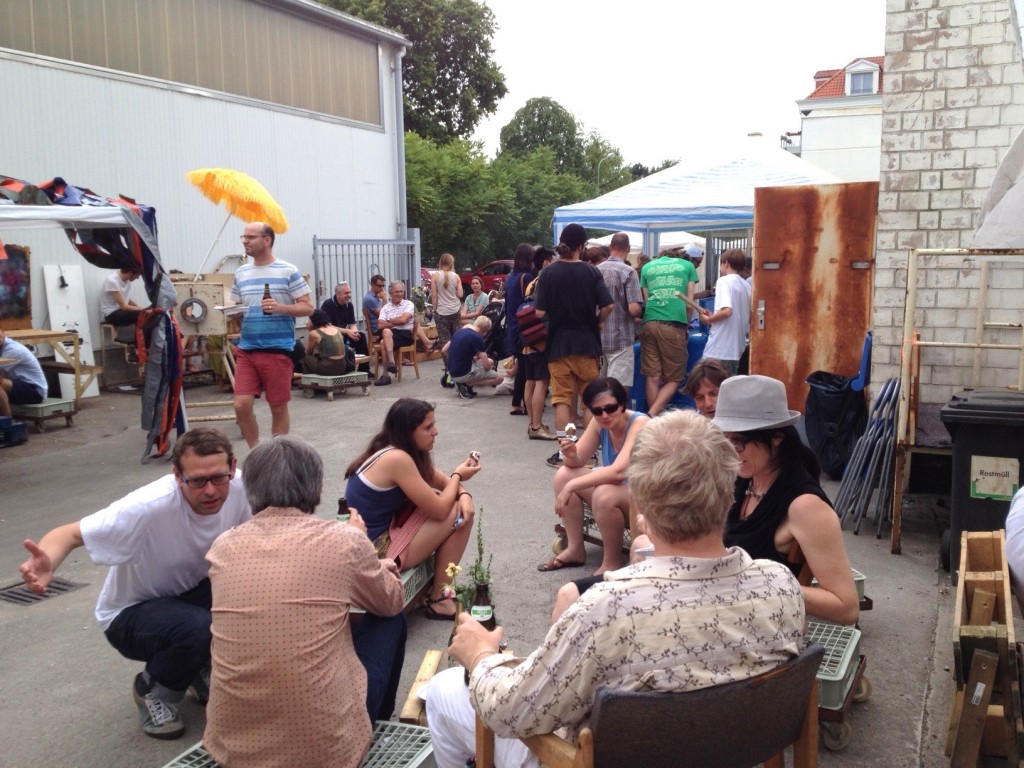Two short weeks ago, art students from an Offenbach university located in the heart of Germany occupied every floor of a closed-down, multi-tier soap factory building. They used the space to excitedly display their art to the public. Considered by a few of these students to be the ‘Detroit’ of Germany, Offenbach itself is situated on the outskirts of Frankfurt—the German banking city responsible for maintaining most of Germany’s wealth. Many of the young artists signaled nearby Frankfurt as the undeniable European economic hub, while at the same time poking fun at the poorer economic status of Offenbach in particular. There was no way of quieting the suspicion that their friendly self-deprecation also served to buffer their art from any criticism that might be too serious and unwarranted by the occasion. Even so, they invariably asked, “You came all the way to Germany—to see Offenbach?”
While part of the soap factory complex still functioned to produce some soap with remaining materials, it was nonetheless curious to see every single floor of one of the tallest industrial buildings in Offenbach used as exhibition space for dozens of student art projects. Newspapers and photographers from national syndicates promptly flooded the floors of the transformed art space. Each was eager to be the first to capture the highly ephemeral essence of what was happening there. Each was hungry to harness the dynamic between withering failed industry and the exploding blossom of new art and young life.
The occupation of the closed soap factory also received a warm welcome from the factory owner. This was yet another curiosity. Given the usual response to many student-driven political movements around the world, and given the usual antagonisms brokered by a clash between the powers that be (industrial capitalists in this case) and people along the democratic fringes, to witness a factory owner smile and then appreciate the art and its political underpinnings in this multicultural and working-class city was something oddly new. The owner was present only once, and for a brief moment. He also seemed rather friendly with Heiner Blum, the professor who helped facilitate the use of the building as a multi-studio exhibition space. Most interactions involving the owner and the professor appeared rather quaint and polite, superficially speaking, with smiles and light palavering as perhaps was the German norm.
Offenbach itself teemed with pluralism, an element perhaps only aptly reflected by the individual diversities of the art students who came from all over the world to study there. There was no telling where Armenian, Russian, Turkish or Lebanese neighborhoods ended, and where the Germany of lore began. This very dynamic also lent itself in a peculiar way to the very occupation of the old soap factory: Germans from outside of Offenbach were easy to spot as they navigated the grounds so uncommunicatively. These were the invariable art aficionados who found themselves in some emergent vortex of local color that made at once no sense and complete sense. Of course, there were other peculiar elements worthy of mention, elements which added to a general air of incredulity: American hip-hop music blared in the background, German beer and Apple wine flowed from one bottle to the next, and Afghan food perfumed the hot summer air. The milieu in which these art students expressed themselves and perfected their crafts was eclectic and beautiful to say the least. It all served to enrich the deeper, underlying meanings that gave rise to the event in the first place.
Politically speaking, many things came to light during the exhibition. In Offenbach, art students of perhaps the most diverse backgrounds in all of Germany collaborated on different art projects. One young artist in particular, Viviane Niebling, incorporated into her spontaneous bar projects the Offenbach diversity that was so emblematic of surrounding neighborhoods. Meant to bring different walks of life together so as to share in something happy, fun and unprompted, Ms. Niebling used only available materials found on the streets to construct her bars. She took her project so far as to repurpose rubbish and build spur-of-the-moment bars to unite neighbors of different cultures, languages, faiths and strata. Her hope was to unite people often isolated by otherwise arbitrary cultural elements, and to bring them together in an earnest spirit of fraternity and sorority.
Another student, Max, hailing from Malaysia, spoke to me of his many run-ins with German police. They often accosted and detained him for the suspicion of theft or drugs. He made it plainly clear that the brown color of his skin constantly attracted trouble from the police. Next to another black student, and also a white one, Max indicated that German police discriminated not just based on race and appearance, but also by the degree of darkness of ones skin. Recently stopped by the police, the two students of lighter complexion were not even searched, while Max was thrown to the ground and immobilized. The three collaborators all expressed their disdain for not only the police’s proclivity for racial profiling, but also for Germany’s political denial of gang problems and terrorist radicalization within Germany’s borders.
Another artist, Markus, expressed his disappointment with the faulty translations of American news from English to German. “They show school shootings, and they say that, oh, everything is fine,” said Markus, “but we know English, and that’s not what they are saying!” Others also vetted the distortion of the news that came from America regarding violence there. Most agreed that the farce warrants little believability, as most Germans maintain a working proficiency of English.
So many of these German art students in Offenbach spoke to me about the demonization of the American people in the different mediums for popular culture in Europe. One painter, Gregor, expressed his confusion about the seeming American hatred for bipartisanship, and that despite the ubiquitous depictions of the ‘ugly American’ in European films, songs and writings, he refused to believe that Americans were truly “the scum of the Earth.” Another friend invoked his travels through Brooklyn, Philadelphia and Missouri, somewhat to nuance Gregor’s disbelief. He made it a point to express his admiration for the young people in the States who take entrepreneurship seriously, and who strive to alter the normal relationships between politics and business as usual with new concepts involving art, spaces, bars, farmers markets, etc. He, too, hoped that German youth might take up some of their American counterparts’ initiatives in this sense, if only to help ensure a more democratic control of business in his own country as its very makeup continues to drastically change.
Many of these young Offenbach artists were highly attuned to the cultural problems (both domestic and foreign) that plagued their society. It was no wonder that their art truly exhibited a limitless quality throughout the halls of the eclipsing soap factory. The diversity that inspired Ms. Niebling, for example, is what made the whole spectacle so special. These artists and their professor endeavored to produce art in the hopes of transforming the spaces of dilapidated industry into a nationally recognized art exhibition. It was a tour de force for the staying power of art in today’s world. Moreover, witnessing this movement in a city like Offenbach not only made it all the more special to neighbors and visitors, but also it was the very element that made it altogether possible. In all, students exhibited the radical change that started to take place not only in old buildings throughout waning cities like Offenbach, but also in the old spaces of Europe, and the world.












